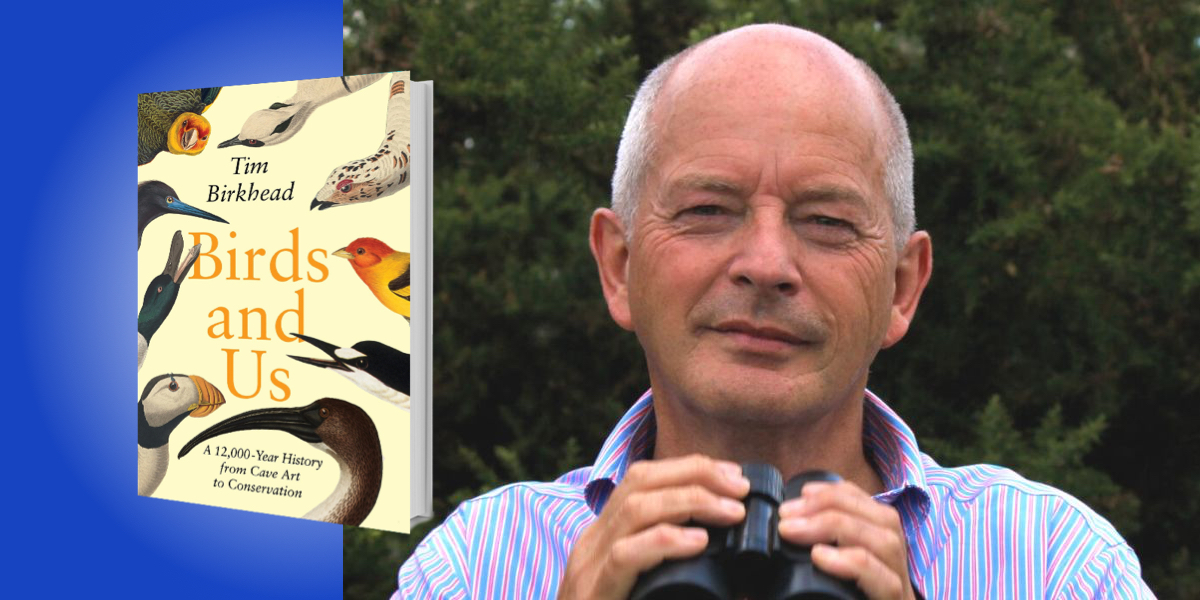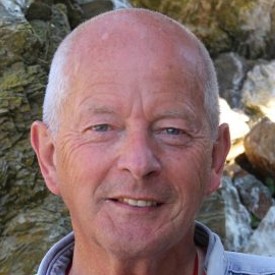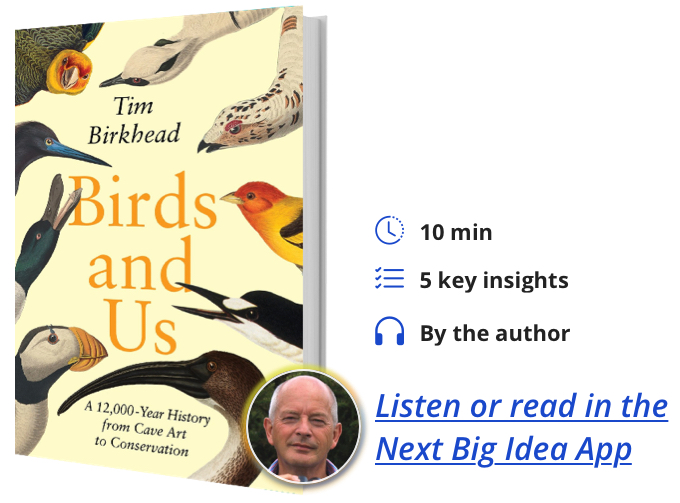Tim Birkhead is an ornithologist who has spent a lifetime studying birds in both a personal and professional capacity. He has received numerous awards for his research, undergraduate teaching at the University of Sheffield, and for his science writing, which has been featured in The Guardian, The Independent, and BBC.
Below, Tim shares 5 key insights from his new book, Birds and Us: A 12,000-Year History from Cave Art to Conservation. Listen to the audio version—read by Tim himself—in the Next Big Idea App.
1. The beginnings of bird observation.
Birds aren’t featured often in Paleolithic or Neolithic art, but there is a tiny cave in southern Spain in which over two hundred bird images were painted in red and yellow ochre on its walls. Who created these images, and for what purpose? What can these images reveal about early bird watchers and past populations of birds in this region of Spain?
The cave, known as El Tajo de las Figuras, lies adjacent to what was once a vast wetland at the synapse that connects Europe to Africa. Almost unimaginable numbers of migratory birds appeared there each spring and autumn. Scholars have speculated about the function of cave art, but I wonder whether the Neolithic images in El Tajo served as a hunting tutorial—a way for experienced hunters to show their pupils how to identify different species, and how to secure them for the cooking pot. This remarkable cave represents the very cradle of European ornithology.
2. Knowledge of birds has changed over time.
Our ancient ancestors knew a lot about the habits of birds, but as we became less dependent on birds for food, that knowledge was eventually lost. Aristotle helped kick off the re-acquisition of such knowledge, but it was only with the Scientific Revolution in the 1600s that objective knowledge became actively sought after. The pioneers in the study of birds were John Ray and Francis Willughby: they produced the first decent encyclopedia of ornithology in 1676. Another revolution in our ornithological understanding started in the mid-1970s with the development of behavioral ecology.
“Our ancient ancestors knew a lot about the habits of birds, but as we became less dependent on birds for food, that knowledge was eventually lost.”
Behavioral ecology triggered a massive increase in scientific research, suddenly making sense of bird behaviors that had once seemed inexplicable. For example, Willughby and Ray knew that bird species differed in the size of their testes, but had no idea why. Once it was discovered—in the mid-1970s—that many birds are promiscuous, it was found that males of the most promiscuous species have the largest testes. This is because males with larger testes produce more sperm, and therefore tend to outcompete other males in fathering offspring.
3. Different ways people engage with birds.
There is a popular stereotype of a birder: someone of either sex, middle-aged or older, driving to a bird reserve and then walking along a wooden boardwalk to a comfortable hide from which to spot birds through binoculars. This was not always the norm, and even today people engage with birds in a wide variety of ways.
“Over time, birding made its way down through the social hierarchy until it became a hobby for anyone to enjoy.”
Bird watching had its origins in the late 1800s and early 1900s when the killing of birds for fun or scientific study gradually gave way to a more empathetic attitude that involved the observation and appreciation of living things. By the 1940s, bird watching (enhanced by the popularization of binoculars and the production of excellent field guides) became an increasingly popular hobby. Initially, predominantly upper-class men were birders—though women had spearheaded bird conservation. Over time, birding made its way down through the social hierarchy until it became a hobby for anyone to enjoy.
But birding is only one way people engage with birds. Close to where I live in Sheffield, England is a starling roost at which as many as three hundred people gather each winter evening to enjoy the murmuration spectacle. Nearly none of the attendees are what you would call birders. Other people engage with birds by feeding parrots or ducks in local parks, or some folks rear racing pigeons, or breed canaries or budgerigars in their backyards. The different ways people appreciate birds are as intriguing as the birds themselves.
4. The issue of gender.
One of the most marked—and welcome—changes in human relations with birds is that there are now more female bird watchers and scientific ornithologists than ever before. This shift started during the 1930s in the United States when Margaret Morse Nice broke the male-dominated mold by publishing the findings of her pioneering population studies of the Song Sparrow.
“Across the globe, seabird populations have halved in the last fifty years.”
Though other early female role models are hard to track down, another accomplished woman was the little-known Scotswoman, Jemima Blackburn. She was a superb observer, artist, and stickler for scientific accuracy. In the 1870s, she sent a note and an image to the journal Nature, in which she described how a young cuckoo ejected the recently hatched host’s young from the nest. Soon afterward, the internationally renowned ornithologist John Gould used Blackburn’s account to produce his own ideological (and seriously misleading) portrayal of that event. Blackburn wrote to Nature and reiterated what had really happened and chastised Gould for his dishonesty.
5. Concern for birds.
Bird numbers around the globe are in serious decline, for reasons such as habitat loss, intensification of agriculture, climate change, and avian flu. Our long relationship with birds has mainly been one of exploitation, as concern for their conservation is relatively recent. Eighty miles from where I live is one of Britain’s largest and most spectacular seabird colonies: Bempton Cliffs. In the 1850s, people went there to shoot birds for fun. The huge numbers killed, and the fact that they were simply left to rot, caused outrage and resulted in the Seabird Protection Act of 1869—the beginning of bird protection.
For the last fifty years I have run a long-term study of a seabird called the common murre (common guillemots) on Skomer Island, off the coast of Wales, working out how best to monitor their numbers, and to understand how their populations work. This research is especially relevant as climate change shifts ocean currents and pushes food supplies out of reach, resulting in widespread breeding failure. So far, Skomer has not been affected, but elsewhere in the North Atlantic the effects are dire, and across the globe, seabird populations have halved in the last fifty years. It may be a matter of time before Skomer is affected too. We are fiddling as Rome burns.
To listen to the audio version read by author Tim Birkhead, download the Next Big Idea App today:

































